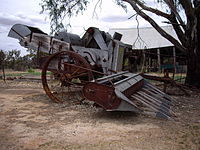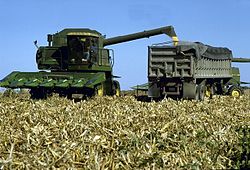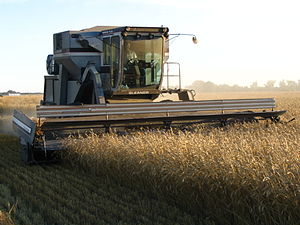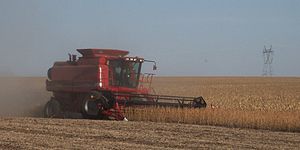
Combine harvester
About this schools Wikipedia selection
This selection is made for schools by a children's charity read more. Sponsoring children helps children in the developing world to learn too.
The combine harvester, or simply combine, also known as a thresher is a machine that combines the tasks of harvesting, threshing, and cleaning grain crops. The objective is the harvest of the crop; corn (maize), soybeans, flax ( linseed), oats, wheat, or rye among others). The waste straw left behind on the field is the remaining dried stems and leaves of the crop with limited nutrients which is either chopped and spread on the field or baled for feed and bedding for livestock.
History
The first combine was invented by Hiram Moore in 1838. It took many decades for the combine to become popular. Early combines often took more than 16 horses to drive them. Later combines were pulled by steam engines. George Stockton Berry joined the combine into a single machine using straw to heat the boiler. The header was over forty feet long, cutting over one hundred acres per day.
Early combines, some of them quite large, were drawn by horse or mule teams and used a bull wheel to provide power. In 1902, a combine could harvest enough grain in one hour to make 10 loaves of bread. Tractor-drawn, PTO-powered combines were used for a time. These combines used a shaker to separate the grain from the chaff and straw-walkers (grates with small teeth on an eccentric shaft) to eject the straw while retaining the grain. Tractor drawn combines evolved to have separate gas or diesel engines to power the grain separation. Newer kinds of combines are self-propelled and use diesel engines for power. A significant advance in the design of combines was the rotary design. Straw and grain were separated by use of a powerful fan. "Axial-Flow" rotary combines were introduced by International Harvester "IH" in 1977. In about the 1980's on-board electronics were introduced to measure threshing efficiency. This new instrumentation allowed operators to get better grain yields by optimizing ground speed and other operating parameters.
Combine Heads
Combines are equipped with removable heads (called headers) that are designed for particular crops. The standard header, sometimes called a grain platform (or platform header), is equipped with a reciprocating knife cutter bar, and features a revolving reel with metal or plastic teeth to cause the cut crop to fall into the head. A cross auger then pulls the crop into the throat. The grain header is used for many crops including grains and legumes.
Wheat headers are similar except that the reel is not equipped with teeth. Some wheat headers, called "draper" headers, use a fabric or rubber apron instead of a cross auger. Draper headers allow faster feeding than cross augers, leading to higher throughputs. In high yielding European crops, such headers have no advantage, as the limiting factor becomes grain separation. On many farms, platform headers are used to cut wheat, instead of separate wheat headers, so as to reduce overall costs.
Dummy heads or pick-up headers feature spring-tined pickups, usually attached to a heavy rubber belt. They are used for crops that have already been cut and placed in windrows or swaths. This is particularly useful in northern climates such as western Canada where swathing kills weeds resulting in a faster dry down.
While a grain platform can be used for corn, a specialized corn head is ordinarily used instead. The corn head is equipped with snap rolls that strip the stalk and leaf away from the ear, so that only the ear (and husk) enter the throat. This improves efficiency dramatically since so much less material must go through the cylinder. The corn head can be recognized by the presence of points between each row.
Occasionally rowcrop heads are seen that function like a grain platform, but have points between rows like a corn head. These are used to reduce the amount of weed seed picked up when harvesting small grains.
Self propelled Gleaner combines could be fitted with special tracks instead of tires or tires with tread measuring almost 10in deep to assist in harvesting rice. Some combines, particularly pull type, have tires with a diamond tread which prevents sinking in mud.These tracks can fit other combines by having adapter plates made, they will fit a JD6620 2WD only having to remove one shield.
Conventional combine
The cut crop is carried up the feeder throat by a chain and flight elevator, then fed into the threshing mechanism of the combine, consisting of a rotating threshing drum, to which grooved steel bars are bolted. These bars thresh or separate the grains and chaff from the straw through the action of the drum against the concave, a shaped "half drum", also fitted with steel bars and a meshed grill, through which grain, chaff and smaller debris may fall, whereas the straw, being too long, is carried through onto the straw walkers. The drum speed is variably adjustable, whilst the distance between the drum and concave is finely adjustable fore, aft and together, to achieve optimum separation and output. Manually engaged disawning plates are usually fitted to the concave. These provide extra friction to remove the awns from barley crops.
Sidehill levelling
An interesting technology is in use in the Palouse region of the Pacific Northwest of the United States in which the combine is retrofitted with a hydraulic sidehill levelling system. This allows the combine to harvest the incredibly steep but fertile soil in the region. Hillsides can be as steep as a 50% slope. Gleaner, IH and Case IH, John Deere, and others all have made combines with this sidehill levelling system, and local machine shops have fabricated them as an aftermarket add-on. Linked pictures below show the technology.
The first levelling technology was developed by Holt Co., a California firm, in 1891. Modern levelling came into being with the invention and patent of a level sensitive mercury switch system invented by Raymond Alvah Hanson in 1946. Raymond's son, Raymond, Jr., produced leveling systems exclusively for John Deere combines until 1995 as R. A. Hanson Company, Inc. In 1995, his son, Richard, purchased the company from his father and renamed it RAHCO International, Inc. In April, 2007, the company was renamed The Factory Company International, Inc. Production continues to this day.
Sidehill levelling has several advantages. Primary among them is an increased threshing efficiency on sidehills. Without levelling, grain and chaff slide to one side of separator and come through the machine in a large ball rather than being separated, dumping large amounts of grain on the ground. By keeping the machinery level, the straw-walker is able to operate more efficiently, making for more efficient threshing. IH produced the 453 combine which leveled both side-to-side and front-to-back, enabling efficient threshing whether on a sidehill or climbing a hill head on.
Secondarily, levelling changes a combine's centre of gravity relative to the hill and allows the combine to harvest along the contour of a hill without tipping, a very real danger on the steeper slopes of the region; it is not uncommon for combines to roll on extremely steep hills.
Newer leveling systems do not have as much tilt as the older ones. A John Deere 9600 combine equipped with a Rahco hillside conversion kit will level over to 44%, while the newer STS combines will only go to 35%. These modern combines use the rotary grain separator which makes leveling less critical. Most combines on the Palouse have dual drive wheels on each side to stabilize them.
Sidehill levelling system in Europe was developed by Italian combines' manifacturer Laverda that still today produces those systems as a leader.
Maintaining threshing speed
Another technology that is sometimes used on combines is a continuously variable transmission. This allows the ground speed of the machine to be varied while maintaining a constant engine and threshing speed. It is desirable to keep the threshing speed since the machine will typically have been adjusted to operate best at a certain speed.
Self-propelled combines started with standard manual transmissions that provided one speed based on input rpm. Deficiencies were noted and in the early 1950s combines were equipped with what John Deere called the "Variable Speed Drive". This was simply a variable width sheave controlled by spring and hydraulic pressures. This sheave was attached to the input shaft of the transmission. A standard 4 speed manual transmission was still used in this drive system. The operator would select a gear, typically 3rd. An extra control was provided to the operator to allow him to speed up and slow down the machine within the limits provided by the variable speed drive system. By decreasing the width of the sheave on the input shaft of the transmission, the belt would ride higher in the groove. This slowed the rotating speed on the input shaft of the transmission, thus slowing the ground speed for that gear. A clutch was still provided to allow the operator to stop the machine and change transmission gears.
Later, as hydraulic technology improved, hydrostatic transmissions were introduced by Versatile Mfg for use on swathers but later this technology was applied to combines as well. This drive retained the 4 speed manual transmission as before, but this time used a system of hydraulic pumps and motors to drive the input shaft of the transmission. This system is called a Hydrostatic drive system. The engine turns the hydraulic pump capable of high flow rates at up to 4000 psi. This pressure is then directed to the hydraulic motor that is connected to the input shaft of the transmission. The operator is provided with a lever in the cab that allows for the control of the hydraulic motor's ability to use the energy provided by the pump. By adjusting the swash plate in the motor, the stroke of its pistons are changed. If the swash plate is set to neutral, the pistons do not move in their bores and no rotation is allowed, thus the machine does not move. By moving the lever, the swash plate moves its attached pistons forward, thus allowing them to move within the bore and causing the motor to turn. This provides an infinitely variable speed control from 0 ground speed to what ever the maximum speed is allowed by the gear selection of the transmission. The standard clutch was removed from this drive system as it was no longer needed.
Most if not all modern combines are equipped with hydrostatic drives. These are larger versions of the same system used in consumer and commercial lawn mowers that most are familiar with today. In fact, it was the downsizing of the combine drive system that placed these drive systems into mowers and other machines.
The threshing process
Despite great advances mechanically and in computer control, the basic operation of the combine harvester has remained unchanged almost since it was invented.
First of all the header, described above, cuts the crop and feeds it into the threshing cylinder. This consists of a series of horizontal rasp bars fixed across the path of the crop and in the shape of a quarter cylinder, guiding the crop upwards through a 90 degree turn. Moving rasp bars or rub bars pull the crop through concaved grates that separate the grain and chaff from the straw. The grain heads fall through the fixed concaves onto the sieves. The straw exits the top of the concave onto the straw walkers.
Since the New Holland TR70 Twin-Rotor Combine came out in 1975, combines have rotors in place of conventional cylinders. A rotor is a long, longitudily mounted rotating cylinder with plates similar to rub bars.
There are usually two sieves, one above the other. Each is a flat metal plate with holes set according to the size of the grain mounted at an angle which shakes. The holes in the top sieve are set larger than the holes in the bottom sieve. While straw is carried to the rear, crop and weed seeds, as well as chaff, fall onto the second sieves, where chaff and crop fall though and are blown out by a fan. The crop is carried to the elevator which carries it into the hopper. Setting the concave clearance, fan speed, and sieve size is critical to ensure that the crop is threshed properly, the grain is clean of debris, and that all of the grain entering the machine reaches the grain tank. ( Observe, for example, that when travelling uphill the fan speed must be reduced to account for the shallower gradient of the sieves.)
Heavy material, e.g., unthreshed heads, fall off the front of the sieves and are returned to the concave for re-threshing.
The straw walkers are located above the sieves, and also have holes in them. Any grain remaining attached to the straw is shaken off and falls onto the top sieve.
When the straw reaches the end of the walkers it falls out the rear of the combine. It can then be baled for cattle bedding or spread by two rotating straw spreaders with rubber arms. Most modern combines are equipped with a straw spreader.
Rotary vs. Conventional Design
For a considerable time, combine harvesters used the conventional design, which used a rotating cylinder at the front-end which knocked the seeds out of the heads, and then used the rest of the machine to separate the straw from the chaff, and the chaff from the grain.
In the decades before the widespread adoption of the rotary combine in the late seventies, several inventors had pioneered designs which relied more on centrifugal force for grain separation and less on gravity alone. By the early eighties, most major manufacturers had settled on a "walkerless" design with much larger threshing cylinders to do most of the work. Advantages were faster grain harvesting and gentler treatment of fragile seeds, which were often cracked by the faster rotational speeds of conventional combine threshing cylinders.
It was the disadvantages of the rotary combine (increased power requirements and over-pulverization of the straw by-product) which prompted a resurgence of conventional combines in the late nineties. Perhaps overlooked but nonetheless true, when the large engines that powered the rotary machines were employed in conventional machines, the two types of machines delivered similar production capacities. Also, research was beginning to show that incorporating above-ground crop residue (straw) into the soil is less useful for rebuilding soil fertility than previously believed. This meant that working pulverized straw into the soil became more of a hindrance than a benefit. An increase in feedlot beef production also created a higher demand for straw as fodder. Conventional combines, which use straw walkers, preserve the quality of straw and allow it to be baled and removed from the field.





